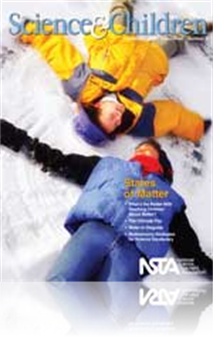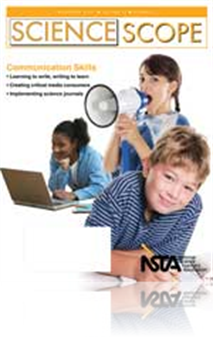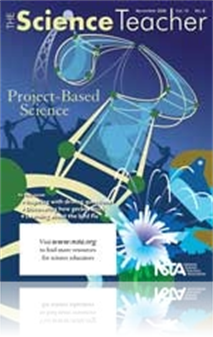All Resources
Journal Article
In an attempt to increase student success in the physical sciences, the authors implemented a system of multiple education reforms in their general chemistry courses to reach diverse learning styles. Results from the study indicated that the reforms ...
Journal Article
The Sport-Utility Vehicle: Debating Fuel-Economy Standards in Thermodynamics
This paper describes a debate about national fuel-economy standards for sport-utility vehicles (SUVs) used as a foundation for exploring a public policy issue in the physical science classroom. The subject of automobile fuel economy benefits from a f...
Journal Article
Using Science Popularizations to Promote Learner-Centered Teaching
This article attempts to evaluate why popularizations seem to generate positive reactions from learners and why the authors find themselves using popularizations more and more frequently. In doing a retrospective analysis, the authors have drawn on t...
Journal Article
Editor’s Note: States of Matter
There is a common misunderstanding of chemicals and chemistry. Chemicals are “bad.” Chemists are a nerdy set in the same category as those zany physicists, except that chemists work with more dangerous materials—“chemicals.” A change in att...
Journal Article
Science Sampler: Environmental Service Learning—The Clean Air Zone Service Learning Project
In September 2006, the Maine Green Schools’ facilitators, consisting of environmental specialists from Maine’s Department of Environmental Protection and Energy Education Program, kicked off the Clean Air Zone Service Learning Project, a campaign...
Journal Article
Favorite Demonstration: Taking Poetic License With Science Instruction
The intersection of science and poetry is, of course, not new. Mixing art into science is a useful pedagogical tool, provided that students are prepared for a novel activity. In the activity described here, poetry and marine ecology are intertwined t...
Journal Article
Every Day Science: December 2008
This monthly feature contains facts and challenges for the science explorer. ...
Journal Article
The Prepared Practitioner: Making Inquiry Successful
In general, moving from structured to guided to open inquiry means increasing student thinking and responsibility—at the highest level, students come up with questions to investigate, figure out how to answer those questions, decide what to observe...
Journal Article
Science Sampler: School yard geology
“Can we break rocks again today?” This statement is typical of the excitement students show for identifying rock types after they apply their rock identification knowledge to the geology in the school yard. Many school yards, although bulldozed d...
Journal Article
Teaching Through Trade Books: The Wonder of Water
Water is an extraordinary substance that we often take for granted. Not only is it what makes our planet uniquely habitable, water is the only substance on Earth that naturally occurs in three different forms. In this month’s column, students will ...
Journal Article
The algebraic concepts and major ideas that govern Newton’s laws of motion can often be a challenge for the majority of ninth-grade students. Therefore, to make learning these concepts less task-oriented and more enjoyable, the author developed les...
Journal Article
Safer Science: Safer Administrative Procedures
How often are your eyewash stations flushed? Do all of your school’s science labs have a direct line of communication with the front office and outside support officials? These and other questions are the focus of what the Occupational Health and S...
Journal Article
Scope on Safety: Flame Tests—A Burning Safety Issue
Flame-test demonstrations are conducted annually in middle and high school science labs across the country. The purpose of the flame test is to help identify an unknown metal or metalloid ion based on a characteristic color the salt produces in a fla...
Journal Article
Science Shorts: Encouraging Visual Literacy
When someone asks you about the solar system or the water cycle, what pops into your mind? Chances are it’s a diagram. Powerful images like these help us understand, communicate, and remember important concepts in science. Learning how to read them...
Journal Article
Editor’s Corner: Doing Science With PBS
Project-based science (PBS) is finding a place in more and more secondary school science programs as teachers discover its power to engage students and develop critical-thinking skills. PBS is firmly rooted in constructivism—the idea that individua...
Journal Article
“It was helpful to keep track of questions we had at the beginning so we knew what we were trying to find out.” With these words, a student described the value of using a Driving Question Board (DQB) in a project-based science (PBS) unit. This i...
Journal Article
Writing about inquiry-based science experiences can provide students with opportunities to communicate their questions, observations, and reflections while expanding our instructional and assessment options as teachers. But how can teachers encourage...
Journal Article
Idea Bank: Performance-Based Assessment
Performance-based assessment is appropriate to use in a project-based, problem-based, or inquiry-based science classroom because it is consistent with the way students learn—by investigating a question or problem using tools and materials (i.e., pe...
Journal Article
Methods and Strategies: Making Time for Science
Some may argue that little can be done to improve the amount of time available for science until policy makers and administrators provide support. Such support is certainly needed. However, individual teachers can make important changes that maintain...
Journal Article
A student recently asked me about the bird flu. Is it still a threat?...
Journal Article
Editor’s Note: Literacy Skills
Our science and literacy issue is always one of the most popular issues of the year, and we’re betting this jam-packed issue will be no exception. Why? There are many probable reasons. Many elementary teachers are more comfortable with teaching s...
Journal Article
Tried and True: Cell organelle employment advertisements
Are you looking for a creative way to teach the functions of cell organelles? If you answered yes, then organelle employment advertisements are just what you need. During this project, students must create an employment ad for a cell organelle and gi...
Journal Article
Invasive species, commonly known as “invasives,” are nonnative plants, animals, and microbes that completely take over and change an established ecosystem. The consequences of invasives’ spread are significant. In fact, many of the species that...
Journal Article
The Science and Literacy Framework
Carefully selected trade books can introduce science concepts, develop background knowledge, reinforce hands-on lessons, support science-process skills, and at the same time enhance related literacy-process skills. They can also provide inspiration a...
Journal Article
Science Sampler: Sculpt-A-Scientist—Confronting negative stereotypes of scientists
Career choice is a process, not an event. Interest in science is a preliminary step toward and prerequisite for a career in science. Once interest in science is established, training and education can then provide the critical links between labor-for...
Journal Article
Idea Bank: Science in Politics
All teachers face the classic struggle of convincing students that material learned in class is important and relevant. However, science teachers are fortunate because much of the material they teach comes up in everyday life. For example, the scienc...
Journal Article
In this article, the authors describe their ongoing experience with the Herpetology Project. Through this field study, students catch and track amphibians and reptiles in the Assabet River area, record and analyze data, share their findings with the ...
Journal Article
Proportionality should be a central focus of the middle-grades science and mathematics curricula and concepts such as density can be introduced and taught in both disciplines, highlighting for students the connections between science and mathematics....
Journal Article
Science Sampler: Using sheltered instruction to teach English Language Learners
Sheltered instruction is not a commercial program but is a set of instructional practices used specifically with English Language Learners (ELL). It embeds existing instructional strategies such as wait time, visual organizers, group work, and allowi...
Journal Article
One way of implementing project-based science (PBS) is to use problem-based learning (PBL), in which students formulate their own problems. These problems are often ill-structured, mirroring complex real-life problems where data are often messy and i...
Journal Article
Teaching Through Trade Books: It’s About Time
“Is it time yet?” is a cry heard from many a student’s mouth. Is it time for lunch? Is it time to go home? Is it time for recess? Is it time for science? (we can always hope)… and the list can go on and on. Students often equate time with an ...
Journal Article
Every Day Science—November 2008
This monthly feature contains facts and challenges for the science explorer. ...
Journal Article
Understanding how geckos—small lizards belonging to the family Gekkonindae—can “defy gravity” and walk across a ceiling provides a fascinating frame through which students can not only learn valuable content about electrostatic forces, but al...
Journal Article
Designing the Perfect Plant: Activities to Investigate Plant Ecology
Plant ecology is an important subject that often receives little attention in middle school, as more time during science classes is devoted to plant biology. Therefore, the authors have developed a series of activities, including a card game—Design...









